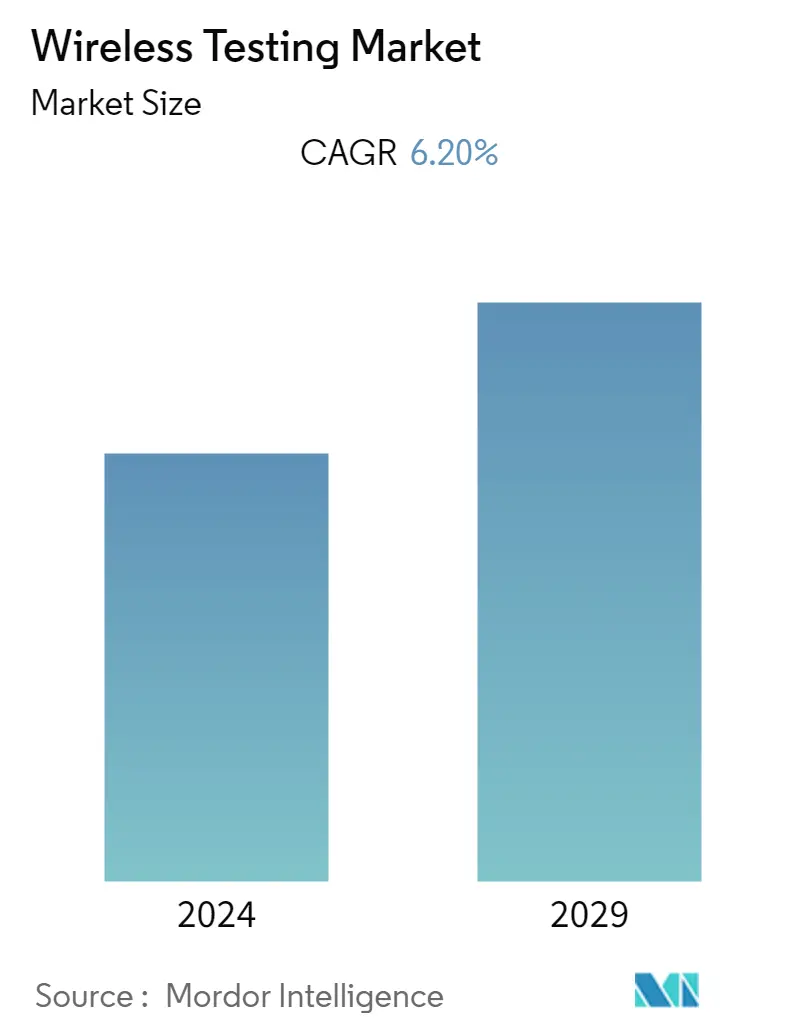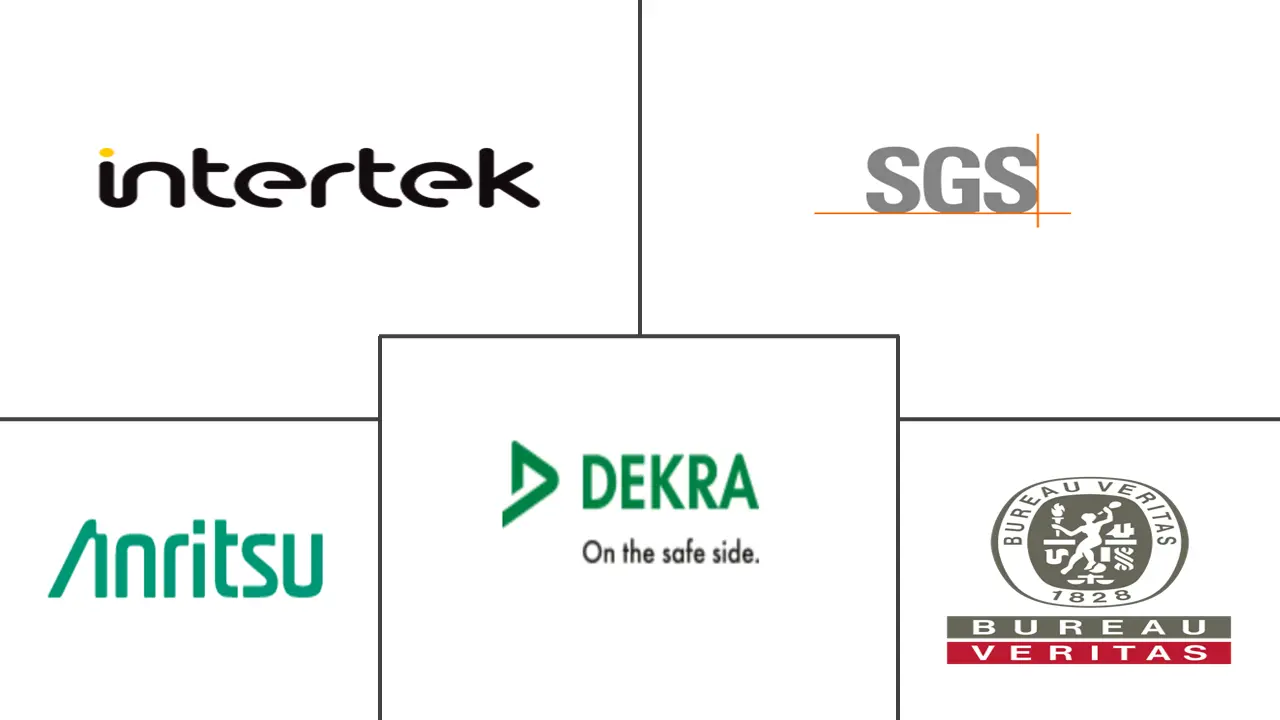Market Size of Wireless Testing Industry

| Study Period | 2019 - 2029 |
| Base Year For Estimation | 2023 |
| CAGR | 6.20 % |
| Fastest Growing Market | Asia-Pacific |
| Largest Market | North America |
| Market Concentration | Low |
Major Players
*Disclaimer: Major Players sorted in no particular order |
Wireless Testing Market Analysis
The wireless testing market is expected to register a CAGR of 6.2% during the forecast period. Wireless technology has evolved to communicate voice, data, and video worldwide over the years. Additionally, the emergence of machine-to-machine communication and IoT sensors connected to the internet for full-time access has driven the demand in the wireless testing market.
- Wireless testing assesses products' real-time performance and functionality consisting of wireless technologies such as Bluetooth, WiFi, and cellular connectivity. Wireless technology has evolved to communicate voice, data, and video globally over the years. Additionally, the emergence of machine-to-machine communication and IoT sensors connected to the internet for full-time access has driven the demand for the wireless testing market.
- Over the past few years, IoT has caused a tremendous shift in the field of electronic design, with processors and wireless components now finding their way into analog technology. As this shift introduces a new level of complexity into the design process, test equipment has followed the trend, rising to new heights of customization and integration.
- Different jurisdictions around the globe require manufacturers to comply with codes and regulations regarding how their wireless products function for security, health, and safety purposes. Third-party conformity assessments also help to strengthen the manufacturer's competitive position in the market.
- There is an increasing market of devices that use different types of wireless technologies, such as radio signals and wireless power transfer (WPT). Government standards regulate the radiation of electromagnetic fields in most international markets, including the European Union, the United States, Canada, Australia, and Japan. This applies to both radio and WPT devices.
- In November 2021, the Department of Telecommunications (DoT) granted Reliance Jio Infocomm, Bharti Airtel, and Vodafone Idea a six-month extension to perform 5G trials. Due to this extension, the carriers would conduct 5G experiments until May 2022. Initially, telcos were given until November 26, 2021, to test 5G technology. In May, the DoT awarded a 5G trial spectrum for six months in the 700 MHz, 3.5 GHz, and 26 GHz bands, paving the way for local carriers to partner and develop 5G use cases.
- By technology, 5G is expected to dominate the market since second-generation versions of 5G chips are making their way into products, increasing the sale of 5G-enabled smartphones. This growth is primarily driven by an aggressive 5G build-out in China using the mid-band spectrum.
- All businesses globally with crucial assets for manufacturing goods and services have been experiencing a rapid decline due to the COVID-19 pandemic. The management of such companies has been feeling extreme urgency and panic, putting more emphasis on cutting costs. Since manufacturing activity is low, companies are tempted to eliminate maintenance, resulting in high prices in the future.
Wireless Testing Industry Segmentation
The wireless testing market is segmented by offering (equipment, services), by technology (Bluetooth, Wi-Fi, GPS/ GNSS, 4G/LTE, 5G), by application (consumer electronics, automotive, and IT and telecommunication, energy and power, medical devices, aerospace, and defense), and by geography. The market sizes and forecasts are provided in terms of value (USD million) for all the above segments. Night vision devices, also called image enhancement devices, are built on image-intensifier tubes to collect and amplify infrared and visible light. These devices work by accumulating small amounts of light, comprised of the lower end of the infrared light spectrum, which may be unnoticeable to the naked eye. It is then amplified so that the user can easily detect the image.
| By Offering | ||||
| ||||
| Services |
| By Technology | |
| Bluetooth | |
| Wi-Fi | |
| GPS / GNSS | |
| 4G / LTE | |
| 5G | |
| Other Technolgies (2G, 3G, etc) |
| By Application | |
| Consumer Electronics | |
| Automotive | |
| IT and Telecommunication | |
| Energy and Power | |
| Medical Devices | |
| Aerospace and Defense | |
| Other Applications |
| By Geography | |
| North America | |
| Europe | |
| Asia-Pacific | |
| Rest of the World |
Wireless Testing Market Size Summary
The wireless testing market is poised for significant growth, driven by the rapid evolution of wireless technologies such as Bluetooth, WiFi, and cellular connectivity. The increasing integration of machine-to-machine communication and IoT sensors has further fueled demand, as these technologies require rigorous testing to ensure optimal performance and compliance with global standards. The market is characterized by a competitive landscape, with major players like SGS Group, Bureau Veritas, and Keysight Technologies actively expanding their offerings through strategic partnerships and innovations. The automotive industry, in particular, is witnessing a surge in demand for wireless testing, with spectrum analyzers playing a crucial role in meeting automotive radar test requirements and enhancing road safety.
The proliferation of 5G technology is a key driver in the wireless testing market, as it necessitates advanced testing solutions to support the deployment of 5G-enabled devices and infrastructure. The market is also experiencing a shift towards more complex and integrated testing equipment, reflecting the advancements in wireless technology. Regulatory compliance and third-party conformity assessments are essential for manufacturers to maintain a competitive edge and ensure the security, health, and safety of their products. As the demand for faster and more reliable wireless connections continues to grow, the wireless testing market is expected to expand, offering opportunities for innovation and collaboration across various industries.
Wireless Testing Market Size - Table of Contents
-
1. MARKET INSIGHTS
-
1.1 Market Overview
-
1.2 Industry Attractiveness - Porter's Five Forces Analysis
-
1.2.1 Bargaining Power of Suppliers
-
1.2.2 Bargaining Power of Consumers
-
1.2.3 Threat of New Entrants
-
1.2.4 Threat of Substitutes
-
1.2.5 Intensity of Competitive Rivalry
-
-
1.3 Impact of COVID-19 on the Wireless Testing Market
-
-
2. MARKET SEGMENTATION
-
2.1 By Offering
-
2.1.1 Equipment
-
2.1.1.1 Wireless Device Testing (Ocilloscope, Signal Generators, Spectrum Analyzers, and Network Analyzers)
-
2.1.1.2 Wireless Network Testing (Network Testers, Network Scanners, and Ota Testers)
-
-
2.1.2 Services
-
-
2.2 By Technology
-
2.2.1 Bluetooth
-
2.2.2 Wi-Fi
-
2.2.3 GPS / GNSS
-
2.2.4 4G / LTE
-
2.2.5 5G
-
2.2.6 Other Technolgies (2G, 3G, etc)
-
-
2.3 By Application
-
2.3.1 Consumer Electronics
-
2.3.2 Automotive
-
2.3.3 IT and Telecommunication
-
2.3.4 Energy and Power
-
2.3.5 Medical Devices
-
2.3.6 Aerospace and Defense
-
2.3.7 Other Applications
-
-
2.4 By Geography
-
2.4.1 North America
-
2.4.2 Europe
-
2.4.3 Asia-Pacific
-
2.4.4 Rest of the World
-
-
Wireless Testing Market Size FAQs
What is the current Wireless Testing Market size?
The Wireless Testing Market is projected to register a CAGR of 6.20% during the forecast period (2024-2029)
Who are the key players in Wireless Testing Market?
SGS Group, Bureau Veritas SA, Intertek Group PLC, Dekra SE and Anritsun Corporation are the major companies operating in the Wireless Testing Market.

